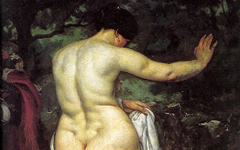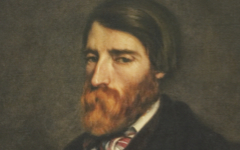Courbet’s Bathers (1853)
This painting caused such a scandal when it was first exhibited that even Delacroix felt compelled to put pen to paper. He ranted on in his diary about the pointlessness of Courbet's idea, the lack of meaning in the gestures and the vulgarity of the forms.1 He nevertheless must have known it was an important picture or he would not have given so much space to it. Perhaps he felt sick that day or was unnerved by an important painting by an upcoming and clearly important artist without understandable subject matter. A few years later he recognized Manet's Absinthe Drinker as an important painting when most others thought it abominable and without meaning.
What Delacroix ought to have recognized (maybe he did) is that the standing woman has the outstretched arm of a painter facing her canvas, her palm open as though touching it. She is "painting" the wooded landscape which appears flat, vertical and almost in her face. We get the feeling, as we should, that she is walking into a wall.
She steps out of a pool, a traditional symbol of generation and creation. Pools, wells, springs and other sources of water have deep resonance in the Western imagination as liminal points between one reality and another. Her passage out of the water clearly suggests this.
Click next thumbnail to continue
The principal bather's figure is large either to indicate the androgyny of the creative mind or because Courbet himself, the individual she represents, was large. Either way the meaning is the same. Many of Michelangelo's women and Rubens' too were large for the same reasons. They are male and female at the same time.
The other woman holding a branch is even more mysterious and will be explained at a later time once the ideas presented on this site are more broadly accepted. The novelty of this painting is that Courbet made even less attempt than earlier artists to hide his underlying meaning with a logical, or almost logical, scene on the surface. The ordinary spectator is left wondering, a prospect for future art that greatly upset Delacroix.
More Works by Courbet
Notes:
1. Courbet, 1819-1877 (London: Royal Academy) 1978, p. 104
Original Publication Date on EPPH: 20 Nov 2010. | Updated: 0. © Simon Abrahams. Articles on this site are the copyright of Simon Abrahams. To use copyrighted material in print or other media for purposes beyond 'fair use', you must obtain permission from the copyright owner. Websites may link to this page without permission (please do) but may not reproduce the material on their own site without crediting Simon Abrahams and EPPH.





